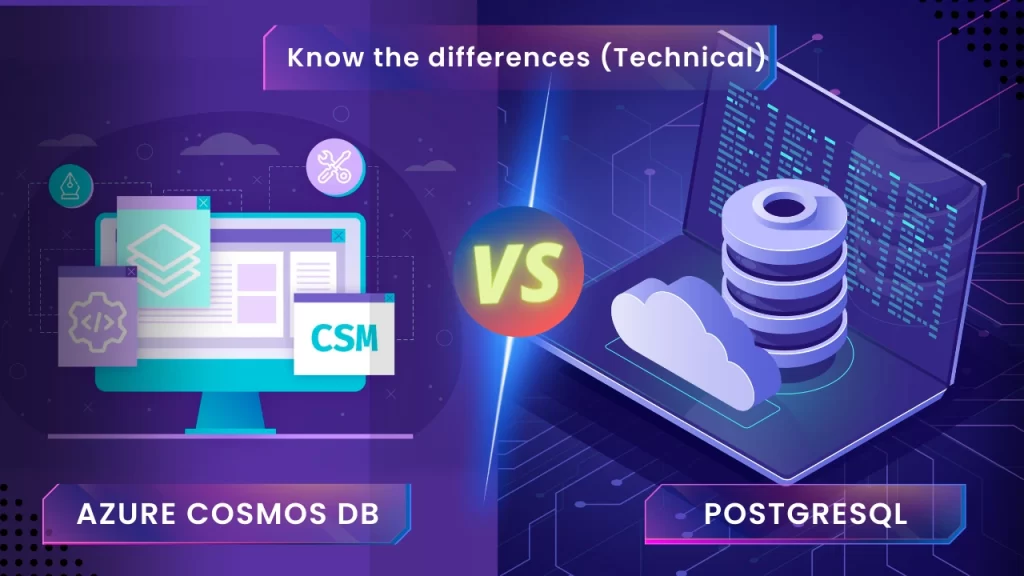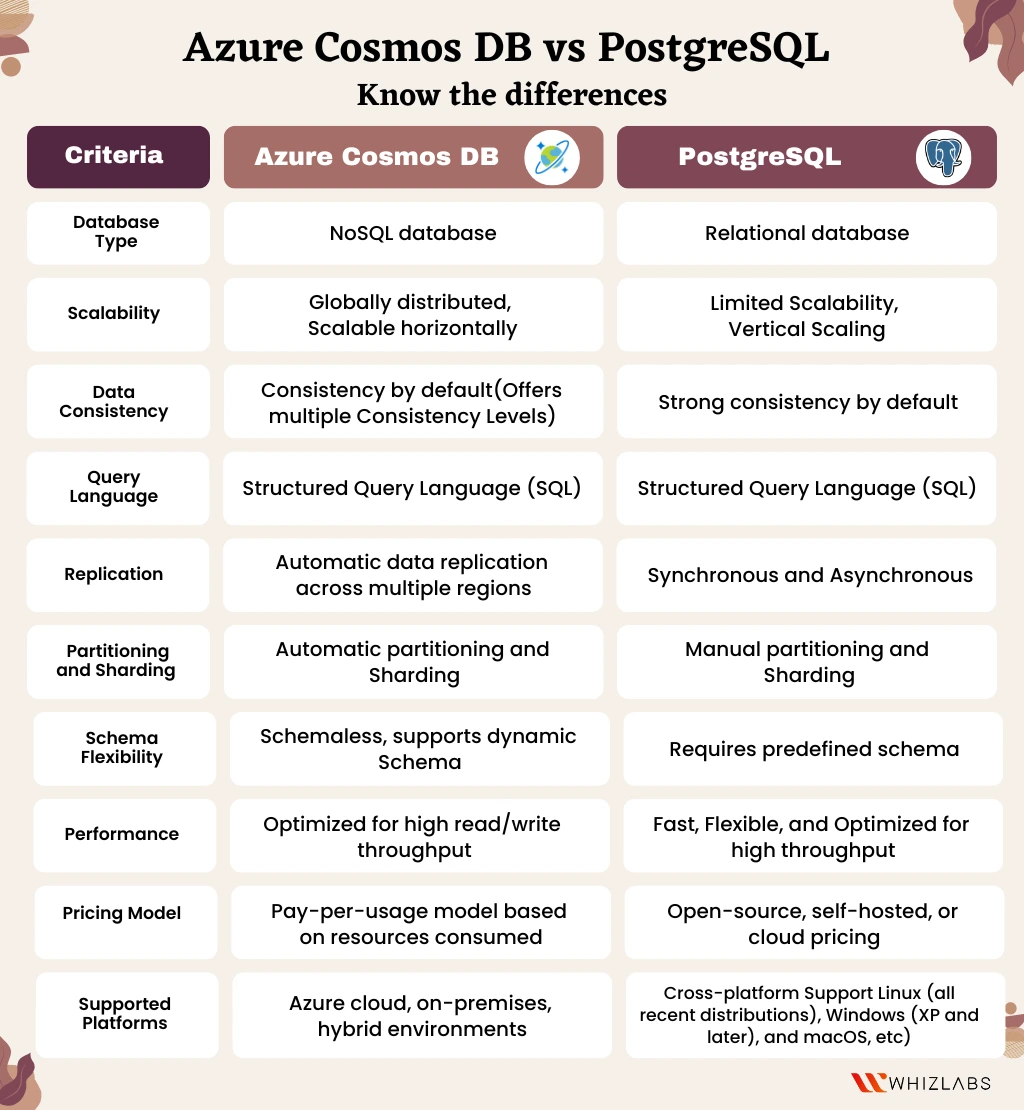When it comes to choosing a database management system (DBMS), there are a plethora of options available. Two popular choices among developers and businesses are Azure Cosmos DB and PostgreSQL. But how do they differ, and which one is the best fit for your needs?
In this blog post, we will delve into the key differences between Azure Cosmos DB and PostgreSQL. We’ll explore their data models, scalability capabilities, querying options, integration with other technologies, and more.
By the end, you’ll have a clear understanding of the strengths and weaknesses of each DBMS, empowering you to make an informed decision for your specific use case.
So, let’s dive in and uncover the unique features and advantages that Azure Cosmos DB and PostgreSQL brings to the table.
What is Azure Cosmos DB?
Azure Cosmos DB is a globally distributed, multi-model database designed for managing large-scale data. It operates as a cloud-based NoSQL database provided as a Platform as a Service (PaaS) through Microsoft Azure. With its low latency, high availability, and high throughput capabilities, Azure Cosmos DB is often referred to as a serverless database. It incorporates the functionality of Azure Document DB and is accessible across various regions.
What is PostgreSQL?
PostgreSQL is a widely used and mature open-source relational database management system (RDBMS). It follows a client-server architecture and offers extensive features for structured data storage and querying. PostgreSQL follows ACID (Atomicity, Consistency, Isolation, Durability) principles to ensure data integrity and reliability. It has a large ecosystem and community support, making it adaptable to different environments and compatible with various development frameworks, ORMs (Object-Relational Mappers), and third-party tools.
Notable features of PostgreSQL
- As it is an open-source database, it offers ease of deployment and higher accessibility, thus allowing the users to set up the database in a quicker way without the need for any external support.
- Additionally, it offers fast throughput and outstanding performance, allowing for effective management of database operations.
- Compared to competing databases like Oracle, MySQL, and SQL Server, PostgreSQL frequently outperforms them in terms of reaction time, effectiveness, and resource management. This makes it a good option for demanding applications and workloads because it constantly exhibits superior performance in these areas.
Azure Cosmos DB vs PostgreSQL: Know the differences
Microsoft Azure Cosmos DB and PostgreSQL are widely used database management systems (DBMS). Let’s explore the key differences between the two:
| S.No |
Azure Cosmos DB |
PostgreSQL |
| Architecture | Azure Cosmos DB is a multi-model, globally distributed database service that offers high availability, low latency, and automatic scaling across multiple regions. It supports different data models such as document, key-value, graph, and column family, providing flexibility for diverse data storage and retrieval requirements. Azure Cosmos DB is designed to handle large-scale, distributed workloads. | On the other hand, PostgreSQL is a relational database management system (RDBMS) that follows a client-server architecture. It adheres to the ACID principles, ensuring atomicity, consistency, isolation, and durability for transactions. PostgreSQL is primarily focused on structured data storage and querying, making it well-suited for relational data modeling and traditional SQL-based operations. |
| Data models | Azure Cosmos DB offers a schema-agnostic data model, providing flexibility for developers to store and query diverse data structures without requiring upfront schema definitions. It employs a JSON-based document model, which makes it ideal for handling unstructured or semi-structured data. This allows for easy adaptation to changing data requirements and enables developers to work with data more flexibly. | PostgreSQL follows a table-based data model that requires predefined schemas and column types. It enforces data consistency by utilizing primary keys, foreign keys, and constraints. This structured approach ensures data integrity and enables strong data typing, making PostgreSQL well-suited for traditional relational data scenarios. |
| Scalability | Azure Cosmos DB provides seamless scalability for global distribution, enabling applications to effortlessly handle massive scale. It achieves this through automatic data replication and horizontal partitioning, allowing data to be distributed across multiple regions. This distributed architecture supports high availability and allows for efficient scaling as workload demands increase. | PostgreSQL requires manual configuration for scaling and is often employed in smaller deployments. While PostgreSQL does support clustering and replication, these features typically require manual setup and management. PostgreSQL’s strength lies in its ability to deliver reliable performance and data integrity in more contained environments. |
| Ecosystem and Integration | Azure Cosmos DB offers seamless integration with other Azure services and tools, making it highly suitable for cloud-native applications developed on the Azure platform. It integrates effortlessly with Azure Functions, Azure Logic Apps, and Azure Event Grid, enabling the creation of event-driven architectures. This level of integration allows for streamlined development and deployment processes within the Azure ecosystem. | On the other hand, PostgreSQL, being an open-source relational database management system, benefits from a large ecosystem and strong community support. It integrates well with various development frameworks, Object-Relational Mappers (ORMs), and third-party tools. This adaptability makes PostgreSQL versatile and compatible with different environments, providing developers with flexibility in their choice of development tools and frameworks. |
| Querying Capabilities | Azure Cosmos DB provides a versatile querying experience through its SQL API, allowing flexible queries across various data models. The SQL API supports querying using SQL-like syntax and also offers compatibility with other APIs, including MongoDB, Cassandra, Gremlin, and Table. This compatibility allows developers to leverage their existing knowledge of query languages associated with these APIs. | In contrast, PostgreSQL utilizes a robust SQL-based query language, offering advanced features such as complex queries, joins, filtering, stored procedures, and user-defined functions. These capabilities enable developers to execute complex logic and perform intricate data manipulations within the database. |
Pros and Cons of Azure Cosmos DB
Pros
The turn-key geo-redundancy with multi-master writes offered by Cosmos DB is unparalleled and unprecedented in the industry. It provides a high level of reliability and availability for your data. Additionally, the guaranteed low latency makes Cosmos DB well-suited for performance-intensive situations.
One of the standout features of Cosmos DB is its tunable consistency model. This feature simplifies many challenges in distributed systems engineering that typically require advanced knowledge of computer science concepts. Cosmos DB abstracts away much of the complexity associated with distributed systems, which is quite impressive.
However, it’s worth noting that Cosmos DB can be expensive if it’s used for scenarios that can be efficiently handled by regular Azure Table Storage or Blob Storage. In such cases, thoughtful system design and considering partitioning schemes can help optimize costs.
Cons
While Cosmos DB provides auto-indexing functionality, it can sometimes be a little mysterious and may require intentional thought. However, this is usually not a major issue and can be managed effectively.
To gain more insight into the resources (DTUs) utilized by individual queries in Cosmos DB, it would be helpful to have access to detailed information and metrics provided by the service.
Overall, Cosmos DB offers powerful capabilities, but it’s important to consider factors such as cost optimization and thoughtful system design to make the most efficient use of the service.
Also Read : Azure Cosmos DB – A Complete Guide
Pros and Cons of PostgreSQL
Pros
PostgreSQL is highly compatible with external data sources and exhibits stable performance on various platforms. This ensures that clients can trust the security and confidentiality of their personal information when using PostgreSQL.
A wealth of forums and online communities provide extensive discussions on the setup and usage of PostgreSQL, and most of these resources are freely accessible. This rich community support system enables users to find helpful guidance and insights.
There are no limitations on adding tooling applications to a computer when working with PostgreSQL. This flexibility allows users to enhance functionality and customize their PostgreSQL environment according to their specific needs.
PostgreSQL is designed to run on multiple operating systems, expanding its reach and accessibility. It also supports ANSI SQL, stored procedures, and triggers, providing a comprehensive set of features for efficient data management and manipulation.
Cons
While horizontal scaling can be complex in general, PostgreSQL offers potential solutions for ensuring that all replicas can accept operations, facilitating improved scalability and distribution of workloads.
PostgreSQL eliminates the need for column re-ordering and offers effective data compression, streamlining data storage and retrieval processes.
However, it’s worth noting that PostgreSQL has sometimes faced criticism for perceived slowness and its suitability for large-scale enterprise applications. It is important to consider that with proper configuration, optimization, and architectural considerations, PostgreSQL can deliver satisfactory performance and has been successfully deployed in numerous enterprise-level scenarios.
Also Know : PostgreSQL Tutorial – A Beginner’s Guide
Conclusion
When deciding between Azure Cosmos DB and PostgreSQL, consider factors such as your data model requirements, scalability needs, performance expectations, and integration with other technologies. Evaluate whether a globally distributed and scalable NoSQL database like Azure Cosmos DB aligns with your application’s demands, or if a mature relational DBMS like PostgreSQL better fits your structured data needs.
Ultimately, the choice between Azure Cosmos DB and PostgreSQL depends on your specific project requirements, preferences, and the trade-offs you are willing to make. Both databases have their unique strengths and it’s important to carefully analyze your needs to make an informed decision that aligns with your business objectives.
To explore the key features and functionalities of each database, you can try out hands-on labs and sandboxes.
If you have any doubts about this blog post, contact our experts today!
- Top 25 AWS Data Engineer Interview Questions and Answers - May 11, 2024
- What is Azure Synapse Analytics? - April 26, 2024
- AZ-900: Azure Fundamentals Certification Exam Updates - April 26, 2024
- Exam Tips for AWS Data Engineer Associate Certification - April 19, 2024
- Maximizing Cloud Security with AWS Identity and Access Management - April 18, 2024
- A Deep Dive into Google Cloud Database Options - April 16, 2024
- GCP Cloud Engineer vs GCP Cloud Architect: What’s the Difference? - March 22, 2024
- 7 Ways to Double Your Cloud Solutions Architect Role Salary in 12 Months - March 7, 2024


